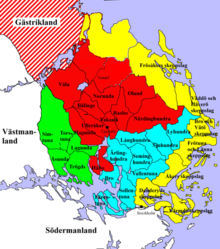Law of Uppland
The Law of Uppland (
It was drafted by a Royal commission, enacted at the three Folkland Things, and given Royal assent in 1296. The Law of Uppland became the law of the land, not only for the province of Uppland it created, containing the three Folklands and Roden, but also for Gästrikland. The law contained eight law codes: The Church, King's, Heritance, Freeman's, Land, Merchant's, Neighborhood, and Thing codes. Courts were held in each Hundred and each Folkland. There were no public prosecutors, and no material difference between criminal and civil cases existed. Suits in law would be initiated by the parties. Legal proceedings were of three kinds: trial by eyewitnesses, trial by compurgation and trial by jury.
Background
In early medieval Sweden, each Land (province) was judicially autonomous with its own legal system, laws and justice (leges terrae). The law originally only existed in a spoken form, recited at the Thing by the Lawspeaker. From the end of the 13th century, the oral laws began on private initiative to be recorded in the form of unofficial law texts (Rechtsbücher). From the Law of Uppland, however, the law codes were formally enacted.[1]
Creation
The area of Uppland, which did not exist before the enactment of the Law of Uppland, contained the three Folklands of Tiundaland, Attundaland, and Fjärdhundraland.[2] The Lawspeaker of Tiundaland, Birger Persson (the father of Saint Bridget) complained to King Birger Magnusson, that the law for the three Folklands were scattered in several different law texts, some of them obscure and sometimes very difficult to comply with. Hence the King appointed Birger chairman of a Royal commission that would draft a new law; removing some provisions, adding some, and merging the old laws of the three folklands into one.[3]
According to the
Jurisdiction

The Law of Uppland became the law of the land, not only for the province of Uppland it created, containing the three Folklands and Roden, but also for Gästrikland.[3] Since the new law of the whole realm, the Magnus Erikssons landslag of 1350, lacked a church code due to opposition from the Church, the church codes of the several provincial laws remained in force even after 1350. Gradually the church code of the Law of Uppland became valid for the whole kingdom, remaining in force until it was partly replaced by the Church Act of 1686 and finally by stipulations in the Civil Code of 1734.[5]
Formal content
The Church code governed the relationship between the
Courts and procedures
A
There were no
Legal proceedings were of three kinds:
Editions
The Law of Uppland is preserved in five complete handwritten copies. The assent is preserved in both a Swedish and a Latin form.[3] A printed version was published in 1607 by Johannes Bureus.[11] The first scholarly edition was published in 1834.[12] A translation to modern Swedish was published in 1933.[13]
References
Citations
- ^ Liedgren 1980-1982, col. 231-232.
- ^ Lundberg 1980-1982, col. 320-321.
- ^ a b c d Lundberg 1980-1982a, col. 332.
- ^ Lagerbring 1773, pp. 657-659.
- ^ Strandberg 1980-1982, col. 684.
- ^ Hafström 1980-1982, col. 472.
- ^ Holmbäck & Wessén 1933, pp. xxxviii-xxxix.
- ^ Holmbäck & Wessén 1933, p. xxxix.
- ^ Wührer 1980-1982, col. 440.
- ^ Holmbäck & Wessén 1933, pp. xxxix-xliii.
- ^ Bureus 1607.
- ^ Schlyter 1834.
- ^ Holmbäck & Wessén 1933.
Cited literature
- Bureus, Johannes (1607). Vplandz laghen, sum af Byrgher Magnusa son Swea ok Giötha kununge, åhrom äfter Ch. b. 1295. förbätradhes. Stockholm.
- Hafström, Gerhard (1980–1982). "Skeppslag." In: Granlund, Johan (ed.) (1980–1982). Kulturhistorisk leksikon for nordisk middelalder fra vikingetid til reformationstid. 2nd edition. Copenhagen, vol. 15: 471-472.
- Holmbäck, Åke & Wessén, Elias (1933). Svenska landskapslagar. Ser. 1, Östgötalagen och Upplandslagen. Stockholm.
- Liedgren, Jan (1980–1982). "Landskabslove: Sverige." In: Granlund, Johan (ed.) (1980-1982). Kulturhistorisk leksikon for nordisk middelalder fra vikingetid til reformationstid. 2nd edition. Copenhagen, vol. 10: 231-233.
- Lundberg, Birger (1980–1982). "Uppland." In: Granlund, Johan (ed.) (1980–1982). Kulturhistorisk leksikon for nordisk middelalder fra vikingetid til reformationstid. 2nd edition. Copenhagen, vol. 19: 320-323.
- Lundberg, Birger (1980–1982a). "Upplandslagen." In: Granlund, Johan (ed.) (1980–1982). Kulturhistorisk leksikon for nordisk middelalder fra vikingetid til reformationstid. 2nd edition. Copenhagen, vol. 19: 331-334.
- Lagerbring, Sven (1773). Swea rikes historia: 1060-1300. Stockholm.
- Schlyter, Carl Johan (ed.) (1834). Corpus iuris sueo-gotorum antiqui. Samling af Sweriges gamla lagar, på kongl. maj:ts nådigste befallning utgifven. Vol. 3: Codex iuris Uplandici = Uplands-lagen. Stockholm.
- Strandberg, Carl (1980–1982). "Kyrkobalkar: Sverige." In: Granlund, Johan (ed.) (1980–1982). Kulturhistorisk leksikon for nordisk middelalder fra vikingetid til reformationstid. 2nd edition. Copenhagen, vol. 9: 682-684.
- Wührer, Karl (1980–1982). "Nämnd." In: Granlund, Johan (ed.) (1980–1982). Kulturhistorisk leksikon for nordisk middelalder fra vikingetid til reformationstid. 2nd edition. Copenhagen, vol. 12: 440-447.
